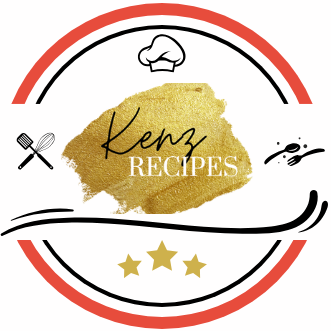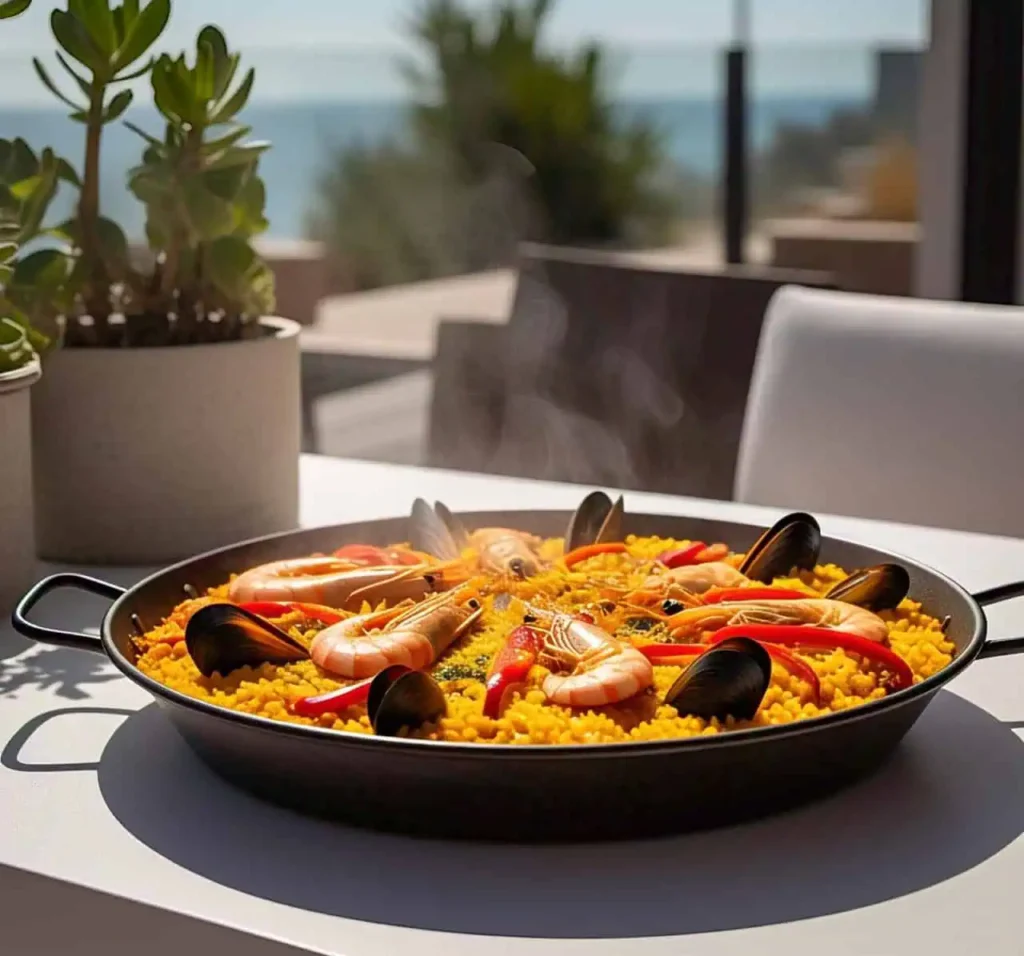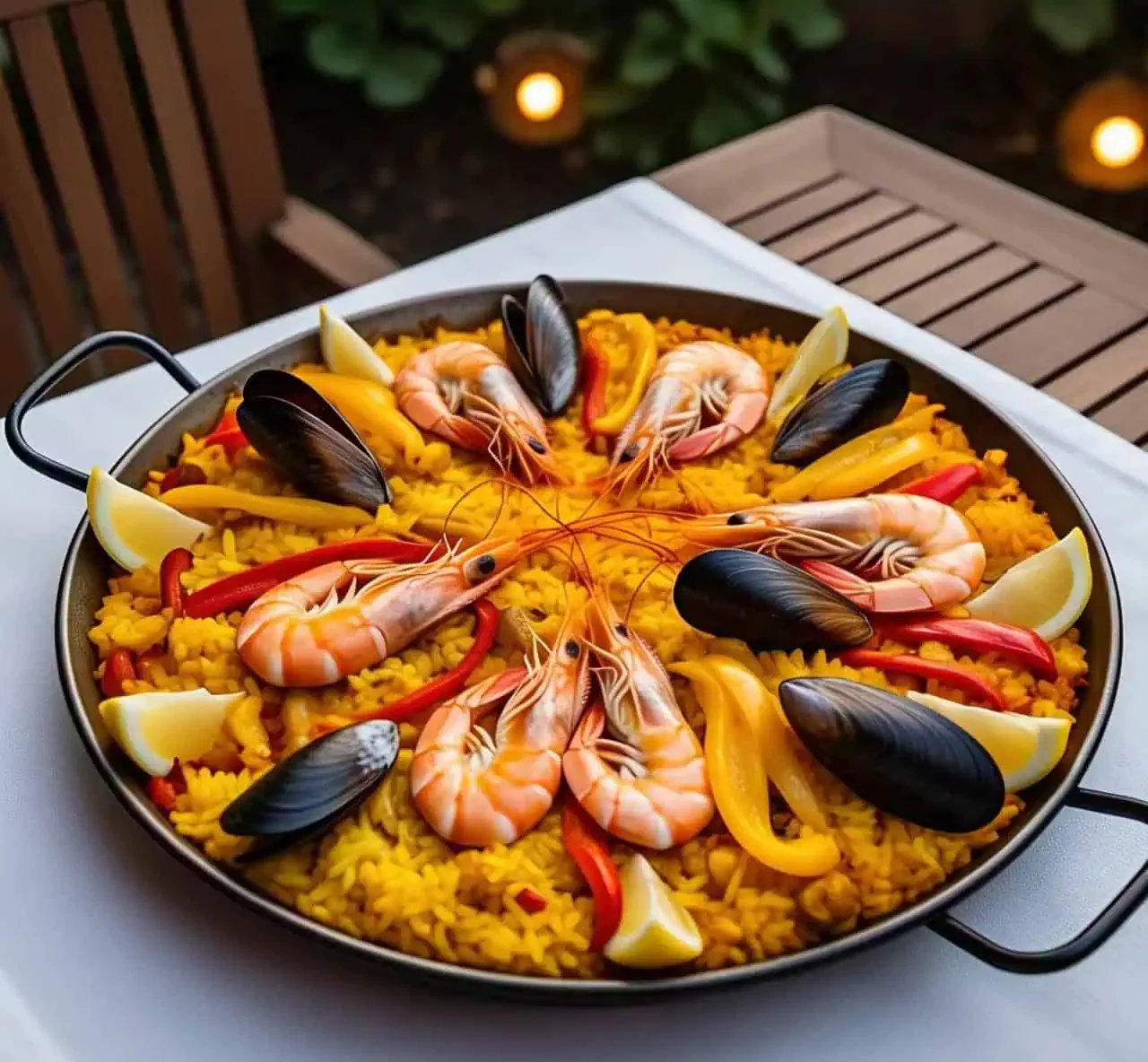Introduction
Paella is one of Spain’s most iconic dishes, known for its rich flavors, vibrant colors, and deep cultural roots. Originating from Valencia, it was traditionally cooked by farmers using locally available ingredients like rice, saffron, vegetables, and meat. Over time, paella evolved into different variations, including seafood paella and mixed paella, making it a beloved dish worldwide.
Beyond being a meal, paella represents Spanish culture and togetherness, often prepared for family gatherings and festivals. This article explores the history, ingredients, cooking methods, and cultural significance of paella, guiding you on how to create an authentic version at home.
Table of Contents
The Origins of Paella
1. The Birthplace of Paella: Valencia
The roots of paella lie in Valencia, a coastal region in eastern Spain known for its fertile lands and rice cultivation. During the 8th century, the Moors introduced rice to Spain, and Valencia’s wetlands became ideal for growing it. Over time, rice became a staple ingredient in the region, and Valencian farmers and laborers began cooking it with available ingredients such as vegetables, rabbit, and duck.
The word “paella” itself comes from the Old French word “paelle,” meaning “pan.” The dish was traditionally cooked outdoors in large, shallow pans over an open fire, allowing the rice to absorb the rich flavors of saffron, broth, and meat.
Paella’s Connection to Moorish Influence
The Moors, who ruled Spain for centuries, played a significant role in shaping the cuisine of the Iberian Peninsula. Their introduction of irrigation techniques allowed rice to thrive in Valencia, and their use of spices like saffron and cinnamon influenced Spanish cooking. While the Moors did not invent paella, their agricultural advancements laid the foundation for its creation.
Paella as a Symbol of Spanish Identity
Although paella has its origins in Valencia, it has become a national and international symbol of Spanish cuisine. Today, you can find regional variations throughout Spain and even unique adaptations in other countries. However, true Valencians take pride in maintaining the authenticity of their traditional paella, ensuring it stays true to its roots.
2. Why is Paella So Special?
Paella is not just a meal; it represents Spanish culture, tradition, and togetherness. It is often cooked for large gatherings, served at festivals, and enjoyed with family and friends. The act of cooking paella is just as important as eating it, with Spaniards treating it as a social event rather than just a dish.
Traditional vs. Modern Paella
1. Authentic Valencian Paella: The Original Recipe
Key Characteristics of Traditional Paella
Ingredients: The true Paella Valenciana consists of:
- Bomba rice (or similar short-grain rice)
- Rabbit and chicken (sometimes duck)
- Green beans (judía verde or ferraura)
- Butter beans (garrofón)
- Tomato
- Olive oil
- Saffron (for color and flavor)
- Water and salt
- Paprika
Cooking Method:
- Paella is never stirred once the rice is added, allowing a crispy bottom layer to form, known as “socarrat”—one of the most prized aspects of an authentic paella.
- It is cooked in a large, shallow pan over an open fire or gas burner.

No Seafood! Contrary to what many people think, the original paella does not include seafood.
2. The Rise of Modern Paella
Popular Modern Paella Variations
🔸 Seafood Paella (Paella de Mariscos) – One of the most popular versions, replacing meat with shrimp, mussels, squid, and clams. It uses fish stock instead of chicken broth for a distinct ocean flavor.
🔸 Mixed Paella (Paella Mixta) – A combination of both meat (chicken, rabbit, or chorizo) and seafood, making it a favorite in many restaurants worldwide.
🔸 Vegetarian Paella (Paella de Verduras) – A plant-based version that includes seasonal vegetables like bell peppers, artichokes, asparagus, and mushrooms. Perfect for those who don’t eat meat or seafood.
🔸 Black Rice Paella (Arroz Negro) – A unique variation where squid ink is added to the rice, giving it a deep black color and rich umami flavor.
🔸 Paella with Chorizo – While chorizo is NOT traditionally included in Spanish paella, many international versions, especially in the UK and the US, use it for a smoky, spicy kick. However, adding chorizo is controversial among Spaniards, as it changes the dish’s original flavor.
Key Differences Between Traditional and Modern Paella
| Aspect | Traditional Paella (Paella Valenciana) | Modern Paella |
|---|---|---|
| Main Ingredients | Chicken, rabbit, green beans, saffron, bomba rice | Seafood, chorizo, vegetables, or a mix |
| Broth/Base | Chicken broth | Fish stock or mixed stock |
| Cooking Style | Open fire or gas, never stirred | Can be cooked on stovetop, sometimes stirred |
| Texture | Crispy bottom (socarrat) | Softer texture in some versions |
| Most Popular Region | Valencia | Worldwide |
Essential Ingredients for Paella
The secret to an authentic and flavorful paella lies in the quality and combination of ingredients. While variations exist, there are some key components that define a great paella. Each ingredient plays a crucial role in creating the dish’s signature taste, texture, and aroma.
1. The Right Rice – The Foundation of Paella
The most important ingredient in paella is rice. Choosing the wrong type can completely change the texture of the dish.
Best Types of Rice for Paella:
- Bomba Rice – The most traditional and preferred rice for paella. It absorbs three times its volume in liquid without becoming mushy, ensuring the perfect texture.
- Calasparra Rice – Another short-grain variety from Spain, similar to bomba rice, known for its ability to absorb flavors well.
- Senia or Bahia Rice – Used in Valencia, these varieties also work well for traditional paella.

Rices to Avoid:
- Long-grain rice (e.g., basmati or jasmine) – Does not absorb enough liquid and lacks the creamy texture needed for paella.
- Sticky rice (e.g., sushi rice or risotto rice) – Too starchy and changes the consistency of paella.
Health Benefits of Rice (www.healthline.com)
2. Saffron – The Golden Ingredient
Saffron is one of the most expensive spices in the world, but it is essential for an authentic paella. It gives the rice its golden-yellow color and adds a delicate floral and earthy aroma.
🔸 Alternative to Saffron (if unavailable or too expensive):
- Turmeric – Can provide a similar color but lacks the distinct saffron flavor.
- Paprika – Adds a smoky depth to the dish but does not replicate saffron’s unique taste.
💡 Pro Tip: Always buy high-quality saffron threads, not powdered saffron, to avoid artificial coloring and diluted flavors.
3. Broth or Stock – The Flavor Booster
The broth is what infuses the rice with flavor. Using homemade stock is always best, but you can also use a good-quality store-bought version.
- Chicken broth – Used in Paella Valenciana.
- Seafood broth – Used in seafood paella for a rich, ocean-like taste.
- Vegetable broth – Used in vegetarian paella.
💡 Pro Tip: For extra depth, dissolve a pinch of saffron in warm broth before adding it to the paella.
4. Proteins – Meat, Seafood, or Both?
Different types of paella use different proteins.
For Traditional Valencian Paella:
✔ Chicken and Rabbit – The classic meats used in authentic Paella Valenciana.
✔ Snails (optional) – Traditional but not commonly used outside Spain.
For Seafood Paella:
✔ Shrimp or Prawns – Provide a sweet, briny flavor.
✔ Mussels & Clams – Add an authentic Mediterranean touch.
✔ Squid or Octopus – Gives a chewy texture and deep ocean taste.

For Mixed Paella:
✔ A combination of chicken, seafood, and sometimes chorizo.
💡 Pro Tip: Never mix seafood with chorizo if you want a truly Spanish-style paella! Chorizo is not traditional in paella, though some modern versions include it for extra spice.
5. Vegetables – Adding Color and Freshness
Paella includes a mix of vegetables, depending on the variation:
✔ Tomatoes – Used in the sofrito (flavor base).
✔ Green beans & Butter beans – Traditional in Valencian paella.
✔ Red & Green Bell Peppers – Common in seafood and mixed paellas.
✔ Peas & Artichokes – Found in some modern variations.
💡 Pro Tip: Avoid overloading paella with too many vegetables, as it can make the dish too watery.
6. Olive Oil – The Essential Fat
Authentic paella is always cooked with high-quality extra virgin olive oil. It enhances the flavors of the ingredients while helping to create the perfect crispy “socarrat” (the caramelized bottom layer of the rice).
7. Seasonings – The Final Touch
✔ Salt & Black Pepper – Enhances all flavors.
✔ Paprika (Pimentón de la Vera) – Adds a smoky depth.
✔ Garlic – Found in some paella variations for an extra aromatic boost.
💡 Pro Tip: Avoid over-seasoning the paella—let the ingredients shine!
Bringing It All Together
A well-made paella is all about balance—the perfect rice, broth, proteins, and seasonings all coming together in one dish. Using high-quality ingredients and traditional cooking methods ensures that every bite captures the rich flavors of Spain.
Cooking Paella – Step-by-Step Guide
Cooking paella requires patience, attention to detail, and the right technique. When done correctly, it results in a rich, flavorful dish with perfectly cooked rice and a crispy bottom layer (socarrat).
Step 1: Gather Your Ingredients
Before you start cooking, make sure you have all the necessary ingredients prepared. Depending on the type of paella you’re making (Valencian, seafood, or mixed), your ingredients may vary.
Basic Ingredients:
- Bomba rice or another short-grain paella rice
- Olive oil
- Saffron (soaked in warm water or broth)
- Paprika
- Garlic (optional)
- Chicken, rabbit, seafood, or a mix
- Vegetables (such as green beans, tomatoes, bell peppers, or peas)
- Stock or broth (chicken, seafood, or vegetable)
- Salt and pepper
Step 2: Prepare the Paella Pan
✔ Use a large, shallow paella pan to allow even cooking.
✔ Heat the pan over medium-high heat and add a generous amount of olive oil.
💡 Pro Tip: If cooking over an open flame or grill, make sure the heat is evenly distributed across the pan.
Step 3: Sauté the Meat (If Using)
If you’re making Paella Valenciana or mixed paella, start by browning the chicken and rabbit (or other meats) in olive oil.
✔ Sear the meat until golden brown and slightly crispy.
✔ Remove and set aside once cooked.
Step 4: Cook the Sofrito (Flavor Base)
The sofrito is the foundation of flavor in paella.
✔ In the same pan, add chopped tomatoes, garlic, paprika, and salt.
✔ Stir and cook until the mixture thickens and turns a deep red color.
✔ If making seafood paella, add diced bell peppers for extra sweetness.
💡 Pro Tip: The sofrito should be well-cooked to develop deep flavors before adding any liquid.
Step 5: Add the Rice
✔ Pour the Bomba rice into the pan and stir it with the sofrito for 1-2 minutes to coat the grains in oil and flavor.
✔ Spread the rice evenly across the pan—do not stir after this step!
💡 Pro Tip: For perfect texture, use a ratio of 1 cup of rice to 3 cups of broth.
Step 6: Pour in the Broth and Add Saffron
✔ Heat the broth and dissolve the saffron in it.
✔ Slowly pour the broth into the pan, making sure to cover the rice evenly.
💡 Pro Tip: Shake the pan gently instead of stirring to distribute the broth evenly.
Step 7: Arrange the Proteins and Vegetables
✔ If making seafood paella, add shrimp, mussels, clams, and squid on top of the rice.
✔ If using vegetables, evenly distribute them at this stage.
✔ If making Paella Valenciana, return the seared meat to the pan.
💡 Pro Tip: Do not stir the rice! This helps create the crispy socarrat at the bottom.
Step 8: Let It Cook – No Stirring!
✔ Reduce the heat to medium-low and let the paella simmer for 15-20 minutes.
✔ Watch as the rice absorbs the broth and develops its signature texture.
💡 Pro Tip: If the broth evaporates too quickly, add small amounts of hot water to keep the rice moist.
Step 9: Create the Socarrat (Crispy Bottom Layer)
The socarrat is one of the best parts of paella—a slightly crispy, caramelized layer of rice at the bottom of the pan.
✔ Once the liquid is mostly absorbed, increase the heat to high for 1-2 minutes to toast the bottom.
✔ Listen for a light crackling sound—this means the socarrat is forming.
✔ Do not stir or scrape the rice while this happens.
💡 Pro Tip: If you smell burning, lower the heat immediately!
Step 10: Rest and Serve
✔ Once cooked, remove the pan from the heat and cover with a clean kitchen towel.
✔ Let the paella rest for 5-10 minutes to allow the flavors to meld.
✔ Serve directly from the pan and enjoy!

💡 Pro Tip: Traditional paella is eaten straight from the pan with a spoon—no plates needed!
Cooking paella is an art that takes time and practice, but following these steps will help you achieve a flavorful and authentic dish.
Common Mistakes to Avoid When Cooking Paella
Even experienced cooks can make mistakes when preparing paella. To ensure a perfectly cooked, flavorful dish, avoid these common pitfalls:
1️⃣ Using the Wrong Rice – Avoid long-grain or sticky rice; always use Bomba, Calasparra, or another short-grain variety to absorb liquid properly.
2️⃣ Stirring the Rice After Adding Broth – Unlike risotto, paella should not be stirred once the broth is added. Stirring disrupts the formation of socarrat (the crispy bottom layer).
3️⃣ Adding Too Much Liquid – Too much broth can make the paella mushy. Stick to a 1:3 rice-to-liquid ratio for the best results.
4️⃣ Not Letting the Socarrat Form – The crispy layer at the bottom is a key feature of authentic paella. Let the rice cook undisturbed for a few minutes at the end to develop this caramelized texture.
5️⃣ Overloading with Ingredients – Paella is about balance; too many ingredients can overpower the dish. Stick to a few high-quality proteins and vegetables.
6️⃣ Using the Wrong Pan – A wide, shallow paella pan is essential for even cooking. Avoid deep pans that prevent proper evaporation.
7️⃣ Cooking at the Wrong Heat – Start with high heat for browning, medium heat for simmering, and high heat at the end to develop the socarrat.
By avoiding these mistakes, you can create a restaurant-quality paella that captures the authentic flavors of Spain.
Frequently Asked Questions About Paella
What is the most traditional type of paella?
- Paella Valenciana, made with chicken, rabbit, green beans, and saffron.
Can I use any type of rice?
- No, use Bomba or Calasparra rice for the best results.
Why can’t I stir paella?
- Stirring prevents the formation of socarrat, the crispy bottom layer.
What gives paella its yellow color?
– Saffron, though turmeric is sometimes used as a substitute.
Is paella spicy?
- No, traditional paella is flavorful but not spicy.
How long does it take to cook paella?
- About 45 minutes to an hour, depending on the type.
Traditional Paella
Equipment
- Paella Pan
- Mixing bowl
Ingredients
For the Paella Base
- 2 cups Bomba rice or another short-grain paella rice
- 3 tbsp olive oil
- 1/4 tsp saffron soaked in warm water or broth
- 1 tsp paprika
- 2 cloves garlic minced (optional)
For the Proteins and Vegetables
- 1/2 lb chicken cut into pieces
- 1/2 lb rabbit cut into pieces (optional)
- 1/2 lb shrimp peeled and deveined
- 1/4 lb mussels cleaned
- 1/4 lb clams cleaned
- 1 squid cleaned and sliced into rings
- 1 cup green beans chopped
- 1 tomato chopped
- 1/2 cup bell peppers diced
- 1/2 cup peas
For the Broth
- 6 cups stock chicken, seafood, or vegetable
- 1 tsp salt or to taste
- 1/2 tsp black pepper
Instructions
- Heat a large paella pan over medium-high heat and add olive oil.
- If using meat, sear the chicken and rabbit until golden brown, then remove and set aside.
- In the same pan, cook the sofrito by sautéing chopped tomatoes, garlic, paprika, and salt until the mixture thickens.
- Add the Bomba rice to the pan and stir for 1-2 minutes to coat the grains in oil and flavor.
- Heat the broth and dissolve saffron in it. Slowly pour into the pan to cover the rice evenly.
- Arrange the proteins (shrimp, mussels, clams, squid) and vegetables on top of the rice.
- Let the paella simmer for 15-20 minutes without stirring, until the rice absorbs the broth.
- Once the liquid is mostly absorbed, increase the heat for 1-2 minutes to develop the socarrat (crispy bottom layer).
- Remove from heat, cover with a clean towel, and let rest for 5-10 minutes before serving.
Notes
Conclusion
Paella is more than just a dish—it’s a symbol of Spanish culture, tradition, and community. Originating in Valencia, it has evolved into various styles, including Paella Valenciana, seafood paella, and mixed paella.
The key to an authentic paella lies in high-quality ingredients like Bomba rice, saffron, and olive oil, along with proper cooking techniques to achieve the perfect socarrat (crispy rice layer).
Beyond its flavors, paella is a social experience, enjoyed at family gatherings, festivals, and celebrations. Whether sticking to tradition or trying modern variations, paella remains a beloved dish worldwide, bringing people together to share in Spain’s rich culinary heritage.
For more Recipes to Try
Check out these recipes:
- Amlou: The best Moroccan Almond and Argan Oil Spread Recipe
- 7 Moroccan Couscous Recipes: Authentic Recipes, Variations, and Health Benefits


